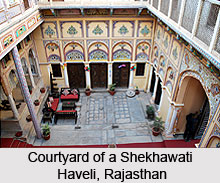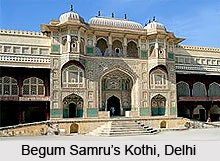 Havelis of India are majestic, spacious, palatial abodes famous for their elaborate architectural styles, stone carvings, intricate art-works, grand chandeliers and several other instances of the influential or royal strata of the society, existent in the ancient India. Indian states like Rajasthan, Delhi, Uttar Pradesh and many others boast of exquisite `havelis`, which are significant contributors to the tourism industry of the economy. They generally contain an extended courtyard equipped with an ornamental fountain at the central portion, while their architectural patterns are inspired by Indian, Central Asian, Persian and Islamic forms of architecture. Large Mughal-styled havelis can be observed in regions which include Jaisalmer, Bikaner, Shekhawati in Rajasthan and Lucknow, Agra in Uttar Pradesh and much more. Havelis in Rajasthan are considered to be some of the most magnificent specimens of impressive architectural grandeur in the nation.
Havelis of India are majestic, spacious, palatial abodes famous for their elaborate architectural styles, stone carvings, intricate art-works, grand chandeliers and several other instances of the influential or royal strata of the society, existent in the ancient India. Indian states like Rajasthan, Delhi, Uttar Pradesh and many others boast of exquisite `havelis`, which are significant contributors to the tourism industry of the economy. They generally contain an extended courtyard equipped with an ornamental fountain at the central portion, while their architectural patterns are inspired by Indian, Central Asian, Persian and Islamic forms of architecture. Large Mughal-styled havelis can be observed in regions which include Jaisalmer, Bikaner, Shekhawati in Rajasthan and Lucknow, Agra in Uttar Pradesh and much more. Havelis in Rajasthan are considered to be some of the most magnificent specimens of impressive architectural grandeur in the nation.
From the Mughals to the Hindus and from the Shekhawats to the rich Goenkas, each Haveli clearly reflects the class and magnificence of its vendor.
Famous Havelis of India
 India is spotted with a number of havelis. Jaisalmer, Delhi, Udaipur, Shekhawati and Jodhpur are home to the best havelis in India. Ghalib Ki Haveli, Nathmal Ki Haveli, Samode Ki Haveli, Kanor Ki Haveli, Sardargarh ki Haveli and Chunnamal Haveli are some popular havelis of India. Some of the popular Havelis of India are as follows:
India is spotted with a number of havelis. Jaisalmer, Delhi, Udaipur, Shekhawati and Jodhpur are home to the best havelis in India. Ghalib Ki Haveli, Nathmal Ki Haveli, Samode Ki Haveli, Kanor Ki Haveli, Sardargarh ki Haveli and Chunnamal Haveli are some popular havelis of India. Some of the popular Havelis of India are as follows:
Havelis of Rajasthan: The word `haveli` was first utilized in Rajasthan by Vaishnava sect for addressing their temples in Gujarat. Later, regional artisans of Rajasthan imitated these temple architecture and their frescoes while constructing the havelis or mansions. Patwon ki Haveli, Jaisalmer, created in 1805 by a merchant named Guman Chand Patwa is said to be amongst the grandest mansions of the area. Manufactured from yellow sandstone, the haveli took 50 years to be completed. Mural paintings adorn its interiors. Another famous haveli of Jaisalmer is Salim Singh ki Haveli which was constructed by the Prime Minister Salim Singh in 1815. Rajasthani motifs and an arched roof decorated with a series of blue peacocks characterize the haveli. Nathmal ki Haveli, which was the residence of Diwan Mohata Nathmal, the then Indian Prime Minister is another architectural wonder, created by two brother architects.
Havelis in Bikaner: These are a marvellous construction in home architecture. In fact it may be said that carvings find best expression in Bikaneri havelies like Binsidhar Newatia Haveli, Murmuria Haveli, Lakshminarayan Ladia Haveli, and Mohan Lal Saraf Haveli. Such havelis or residential houses do not exist anywhere in the world. They are situated in narrow lanes in the old city. Splendid abodes can be seen in the midst of streets that look serpent-like and peaceful. They are marvellous mansions made of red stone and stand magnificently. Originally, the havelies were the residence of wealthy merchants who had a fancy for beauty and art. For a major part of the year, they used to live in far-off lands where they went to earn money. They mostly came back to the city to rest, and enjoy and thus went on to build these havelis for leisure and relaxation. The havelis were a symbol of their wealth and status and their love for architecture and colours.
Havelis in Jaisalmer: These are the 18th and the 19th century`s yellow sandstone mansions that were built by the wealthy merchants. These ancient buildings of Jaisalmer remain unmatched as far as their exquisitely carved sandstone facades; jali screens and oriel windows are concerned. They are the glaring examples of elegant medieval architecture in India created by silavats, a particular community of masons. These are also the witness to the evolution of a different section of society but the most important one, that is, the middle class. These merchants or Marwari merchants distinctly belonged to the middle class or the bourgeoisie.
One of the most interesting local attractions in Mandawa is the havelis that belonged to the rich merchants of Rajasthan. These buildings are scattered throughout the district. The havelis came into existence as the residences of Marwari merchants here. In a way the havelis also reflect the evolution of the middle class. Though the havelis were not as grand as the palaces yet they are worth visiting. Their craftsmanship makes them stand apart from the rest of local attractions. 
Havelis of Shekhawati: These were popular and possessed two courtyards, wherein the outer courtyard was meant for men and an inner courtyard for the womenfolk, constructed by Marwari merchants. The courtyards were ideal for protecting women against the scorching sunlight and unnecessary public interference. They are elaborately painted and consisted of two or three stories. Bikaner city also possesses several significant havelis which include the series of Daga Chowk havelis, Rikhji Bagri ki Haveli, Haveli of Bhairondan Kothari and Rampuria Group of Havelis and so on. Mataji Ki Haveli, Kanor Ki Haveli, Sardargarh Ki Haveli, Salumbar Ki Haveli, Mamaji Ki Haveli and Karjali Ki Haveli are the various Havelis of Udaipur.
Havelis of Delhi: Delhi is home to innumerable old havelis like Begum Samru`s Kothi, Haveli of Hakeem Ashanullah Khan, Haveli of Zeenat Mahal, Namak Haram Ki Haveli, Haider Ki Haveli and so on. However, Chunnamal Ki Haveli, also known as Rai Lala Chunnamal Ki Haveli is the only singular nicely conserved haveli in the national capital of the country. It occupies one acre and is located in Katra Nil area of Chandni Chowk and comprises of 128 rooms and as per an inscription here it was built in 1848.
Other Havelis of India: Apart from these Indian havelis, Haveli Heritage of Marwar, Jodhpur, Purani Haveli in Hyderabad, Andhra Pradesh, ancient havelis at Nangal Sirohi or Mohindergarh, Haryana, etc. are some of the numerous enormous havelis which are scattered throughout India.




